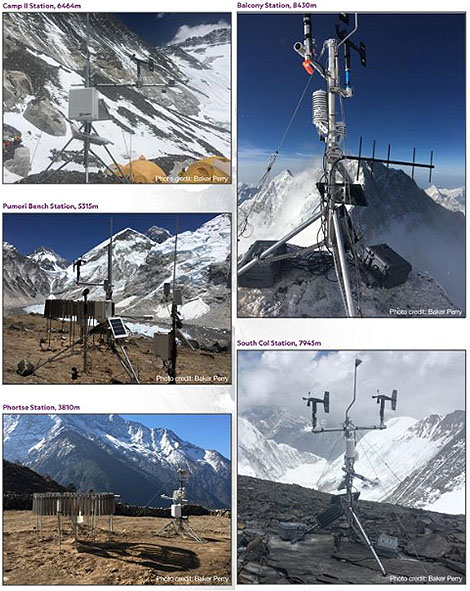Global S&T Development Trend Analysis Platform of Resources and Environment
| Melting Snow and Other Surprises on Mt. Everest | |
| admin | |
| 2020-06-25 | |
| 发布年 | 2020 |
| 语种 | 英语 |
| 国家 | 美国 |
| 领域 | 气候变化 |
| 正文(英文) | 
Despite freezing temperatures, snow is melting on Mount Everest. That’s just one finding in a recent study of weather data provided by a new network of five automated weather stations on Earth’s tallest mountain. The network includes two of the highest altitude weather stations on Earth, Balcony Station at 8,430 m (~27,658 ft) and South Col at 7,945 m (~26,066 ft), and offers “an unrivaled natural platform for measuring ongoing climate change across the full elevation range of Asia’s water towers,” Tom Matthews and his colleagues write in their new article published as an Early Online Release in the Bulletin of the American Meteorological Society. 
The snowmelt is attributed to extreme insolation in the high altitudes of the Himalaya. It enables “considerable” melt up to Camp II at an altitude of 6,464 m (~21,207 ft), “despite freezing air temperatures,” the study reports. And modeling with the data the five stations are providing shows not only is melting occurring at South Col even with average air temperatures of -10°C—which means melting may be common at the tops of all but a small portion of the peaks in the Himalaya—but also is likely happening even at Everest’s peak, Matthews and his team report.
The authors note that while snow melting at the peak of the world’s tallest mountain may be “symbolic” as Earth continues to warm, sublimation of the snowpack appears to be a far greater contributor to its loss at such high altitudes. This finding has implications for the amount of snow that actually falls at extreme altitudes:
Matthews and his coauthors conclude that the data the five AWSs have collected so far offer “rich opportunities” to adjust and improve mountain weather forecasting and melt modeling. |
| URL | 查看原文 |
| 来源平台 | American Meteorological Society |
| 文献类型 | 新闻 |
| 条目标识符 | http://119.78.100.173/C666/handle/2XK7JSWQ/277639 |
| 专题 | 气候变化 |
| 推荐引用方式 GB/T 7714 | admin. Melting Snow and Other Surprises on Mt. Everest. 2020. |
| 条目包含的文件 | 条目无相关文件。 | |||||
| 个性服务 |
| 推荐该条目 |
| 保存到收藏夹 |
| 查看访问统计 |
| 导出为Endnote文件 |
| 谷歌学术 |
| 谷歌学术中相似的文章 |
| [admin]的文章 |
| 百度学术 |
| 百度学术中相似的文章 |
| [admin]的文章 |
| 必应学术 |
| 必应学术中相似的文章 |
| [admin]的文章 |
| 相关权益政策 |
| 暂无数据 |
| 收藏/分享 |
除非特别说明,本系统中所有内容都受版权保护,并保留所有权利。
修改评论